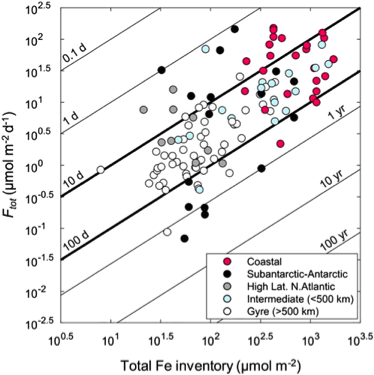When GEOTRACES‐based synthesis efforts improve global iron-cycling understanding
Joint Science Highlight with US-Ocean Carbon & Biogeochemistry (US-OCB).
Authors of a recent paper published in Global Biogeochemical Cycles conducted a detailed study of the residence times of total and dissolved iron (Fe) in the upper layers (0-250m) of the global ocean. Using historical (1987-2007) and recent GEOTRACES data, they compiled an impressive data set comprising dissolved, filtered and trap-collected particulate Fe spanning different biogeochemical oceanographic provinces. They also used indirect isotopic approaches to calculate Fe export from the surface layers (e.g., based on thorium-234-uranium-238 disequilibrium). The study revealed that upper ocean residence times of total Fe consistently fell between 10 and 100 days, despite a broad range of total Fe inventories and ocean biogeochemical settings. Conversely, dissolved Fe residences times were longer and more variable, cycling on sub annual to annual time scales. In addition to these detailed insights on upper ocean Fe cycling, these new data sets will help constrain the rate constant for total Fe export, an important term for exploring links between ocean Fe cycling and the global carbon cycle in ocean biogeochemical models.


Reference:
Black, E. E., Kienast, S. S., Lemaitre, N., Lam, P. J., Anderson, R. F., Planquette, H., Planchon, F., Buesseler, K. O. (2020). Ironing Out Fe Residence Time in the Dynamic Upper Ocean. Global Biogeochemical Cycles, 34(9). DOI: https://doi.org/10.1029/2020GB006592
